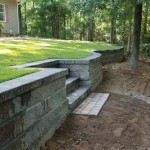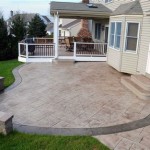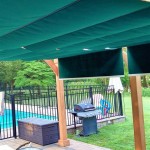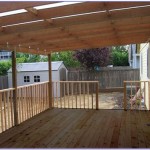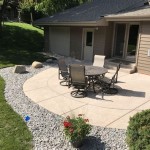How To Install A Concrete Patio
Installing a concrete patio can significantly enhance a home's outdoor living space, providing an area for relaxation, entertaining, and recreation. This project, while demanding, is achievable for the dedicated homeowner with careful planning and execution. The following provides a detailed guide on how to install a concrete patio, covering crucial steps from preparation to finishing.
Planning and Preparation
Successful concrete patio installation begins with meticulous planning. This phase involves defining the patio's location, size, and shape, as well as considering drainage, soil conditions, and necessary permits. Neglecting these initial steps can lead to costly errors and structural issues later on.
First, determine the optimal location for the patio. Consider factors like sunlight exposure, proximity to the house, views, and existing landscaping. The ideal location should be relatively level and easily accessible. Once the location is selected, mark out the desired shape and dimensions of the patio using stakes and string. Ensure the patio's size is adequate for its intended use, accommodating furniture, walkways, and other potential features.
Next, assess the soil conditions in the chosen area. Poor soil can lead to cracking and shifting of the concrete. Conduct a soil test to determine its composition and drainage capabilities. If the soil is primarily clay or contains significant organic matter, it will need to be amended or replaced to provide a stable base. Good drainage is essential to prevent water from pooling under the patio, which can cause frost heave and other problems. Consider incorporating a slight slope (approximately ¼ inch per foot) away from the house to facilitate water runoff.
Before proceeding with any excavation or construction, it is imperative to check local building codes and obtain any necessary permits. This ensures compliance with regulations regarding setbacks, drainage, and environmental protection. Failure to obtain the required permits can result in fines and delays.
Finally, gather all the necessary tools and materials. This includes: * Shovels and rakes for excavation and leveling * Wheelbarrow for transporting materials * Measuring tape and level for accurate layout * Tamper or plate compactor for compacting the base * Circular saw with concrete blade or concrete saw * Concrete mixer or access to ready-mix concrete delivery * Concrete finishing tools (floats, trowels, edgers, groovers) * Safety glasses, gloves, and dust mask * Forms (wood or metal) to contain the concrete * Gravel or crushed stone for the base * Reinforcement (rebar or wire mesh) for added strength * Concrete mix appropriate for patios * Water for mixing concrete * Curing compound to prevent premature drying
Excavation and Base Construction
Once the planning phase is complete, the next step is to prepare the site by excavating the soil and constructing a solid base. This base provides a stable and well-drained foundation for the concrete, preventing settling and cracking.
Begin by removing the topsoil and any vegetation from the area marked for the patio. Excavate to a depth of at least 6-8 inches. The actual depth may vary depending on the soil conditions and the intended thickness of the concrete slab. Ensure the excavation is uniform and extends slightly beyond the planned dimensions of the patio to accommodate the forms.
After excavation, install the forms. These forms will define the shape and edges of the patio and contain the concrete during the pouring process. Use pressure-treated lumber or metal forms, ensuring they are straight, level, and securely staked in place. The forms should be positioned to create the desired slope for drainage.
With the forms in place, add a layer of gravel or crushed stone to the excavated area. This layer should be approximately 4-6 inches thick and helps to improve drainage and provide a stable base for the concrete. Use a rake to evenly distribute the gravel and then compact it thoroughly using a tamper or plate compactor. Proper compaction is crucial to prevent settling and cracking of the concrete.
Before pouring the concrete, consider adding reinforcement to increase its strength and durability. Rebar or wire mesh can be used for this purpose. Rebar should be placed in a grid pattern, typically 12-18 inches apart, and secured with wire ties. Wire mesh can be rolled out over the gravel base and secured with stakes. The reinforcement should be positioned in the middle of the concrete slab to provide optimal strength. This can be achieved by using chairs or supports to hold the reinforcement above the gravel base during the concrete pour.
Pouring and Finishing the Concrete
The pouring and finishing of the concrete are critical stages in the patio installation process. These steps require careful attention to detail and proper technique to ensure a smooth, durable, and aesthetically pleasing surface.
Before pouring, dampen the gravel base to prevent it from absorbing moisture from the concrete mix. This helps to ensure proper hydration of the cement and reduces the risk of cracking. If using ready-mix concrete, arrange for delivery to the site. If mixing the concrete yourself, use a concrete mixer and follow the manufacturer's instructions for the correct water-to-cement ratio. Overly wet concrete is weaker and more prone to cracking.
Begin pouring the concrete into the forms, ensuring it is evenly distributed and completely fills the forms. Use a shovel or rake to move the concrete into place and eliminate any air pockets. Once the forms are full, use a screed board (a long, straight piece of lumber) to level the concrete surface. Rest the screed board on the forms and move it back and forth in a sawing motion to remove excess concrete and create a level surface. This process is called screeding and is essential for achieving a smooth and even patio.
After screeding, use a bull float to further smooth and compact the concrete surface. The bull float is a large, flat tool with a long handle that allows you to reach across the entire patio without stepping on the wet concrete. Use long, overlapping strokes to eliminate any imperfections and bring a layer of fine aggregate to the surface. Avoid over-floating, as this can weaken the concrete.
Once the surface water has dissipated and the concrete has begun to stiffen, begin the finishing process. This involves using a variety of tools to create the desired texture and appearance. An edger is used to round the edges of the patio, preventing chipping and creating a more finished look. A groover is used to create control joints, which are shallow cuts in the concrete that help to control cracking. Control joints should be spaced approximately 8-10 feet apart and should be at least one-quarter the depth of the concrete slab.
After edging and grooving, the final step is to trowel the concrete surface. A trowel is a flat, rectangular tool used to create a smooth, dense finish. The amount of troweling depends on the desired texture. For a smooth, polished finish, multiple passes with the trowel may be required. For a rougher, more textured finish, less troweling is needed. Ensure the concrete is firm enough to support your weight before stepping onto it to trowel.
Texturing the concrete is another option for adding visual interest and improving slip resistance. This can be achieved using a variety of techniques, such as brooming, stamping, or using texture rollers. Brooming involves dragging a stiff-bristled broom across the wet concrete surface to create a textured finish. Stamping involves using rubber or polyurethane stamps to imprint patterns into the concrete. Texture rollers are rolled across the surface to create a repeating pattern.
Curing the Concrete
Curing is a critical step in the concrete installation process, as it allows the concrete to properly hydrate and gain strength. Proper curing prevents premature drying and cracking and ensures a durable and long-lasting patio.
The best method for concrete curing is to keep the surface continuously moist for at least 5-7 days. This can be achieved using several techniques, including: * Sprinkling the concrete surface with water several times a day * Covering the concrete with wet burlap or blankets * Using a curing compound, which is a liquid that seals the concrete surface and prevents moisture from evaporating.
If using water curing, begin as soon as the concrete is hard enough to avoid damage from the water spray. Keep the surface continuously wet for the recommended curing period. If using wet burlap or blankets, ensure they are kept moist at all times. If using a curing compound, apply it evenly over the entire concrete surface according to the manufacturer's instructions. Curing compounds are available in various formulations, including water-based and solvent-based options. Select a curing compound that is appropriate for the specific concrete mix and environmental conditions.
Protect the curing concrete from extreme temperatures, both hot and cold. In hot weather, the concrete may dry out too quickly, leading to cracking. In cold weather, the concrete may freeze, which can also damage its structure. If the temperature is expected to drop below freezing, cover the concrete with insulating blankets or straw to protect it from frost.
After the curing period, remove the forms carefully and inspect the patio for any cracks or imperfections. Small cracks can be repaired with a concrete patching compound. If there are any significant structural issues, consult with a professional concrete contractor to determine the best course of action.
The above steps provide a comprehensive guide to installing a concrete patio. Careful planning, proper execution, and diligent curing are essential for creating a durable, aesthetically pleasing, and functional outdoor living space.

Diy Concrete Patio In 8 Easy Steps How To Pour A Cement Slab

Quikrete Building A Concrete Patio

Diy Concrete Patio How To Pour A Slab Bob Vila

Pouring Concrete Patio What Could Go Wrong With Doing It Yourself

How To Plan Pour Your Diy Concrete Patio Liberty Ready Mix

Diy Concrete Patio How To Pour Your Own Slab Bn S

Quikrete Building A Concrete Patio

Diy Concrete Patio Makeover The Frugal South

How To Prepare A Site For Concrete Base Forms And Rebar

How To Make A Nice Cement Patio Diy Concrete
Related Posts


